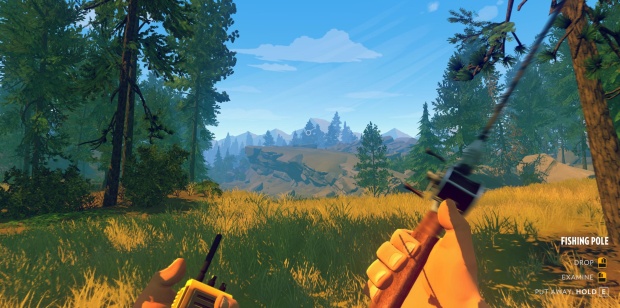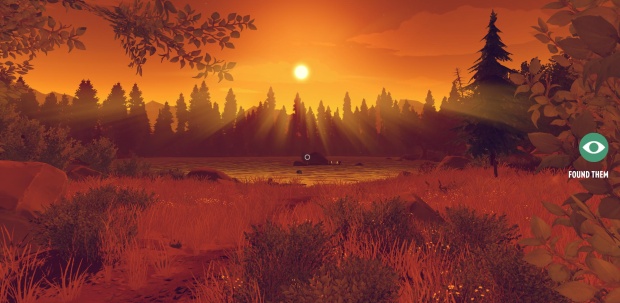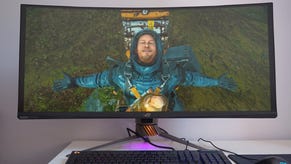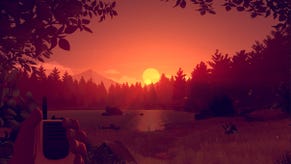The Great Outdoors: Firewatch
Jane Ng on creating the Wyoming Wilderness
While preparing for this year's Game Developers Conference I decided I wanted to learn more about how "outside" works in videogames. By that I mean I wanted to find out how different studios create a sense of space or place that's natural or expansive. Firewatch is not an open world game, but is has these beautiful, expansive vistas, gorgeous trees and a very definite sense of being outdoors. Senior environment artist, Jane Ng, told me more about how the world actually works and how she hides the technical side from players:
"Firewatch is challenging because we have to give this sense that the world is a lot more open," says Ng. "I spent a lot of time thinking about how to fence in the player while not always fencing you in in the sense of surrounding you by a wall – that feels very claustrophobic and wouldn't feel like a forest." One method she mentions is a vista. It still functions as a wall because you can't actually walk into the vista but it's not going to create the same sense of being hemmed in as a big wall of sheet rock towering above you.
Ng likes to hike and so could put bits of real life experience to work in the game, although some of it needed adapting . "How, as a human being, do I know I'm not supposed to go down this?" was one of the questions which would come up. In real life sometimes if an area was particularly steep that would be enough to deter most people, but in a game you get into the habit of brute forcing your way across areas. I've inched my way up mountains in Elder Scrolls games rather than go around the base, bull-headedly shoving the character along terrain in defiance of a smoother but longer experience. In a game like Firewatch you thus need to introduce a consistent gameplay vocabulary so players know what they can and can't do in this world and internalise those rules. "We try to make it very clear from the beginning that you can't go up certain things so as long as you're really consistent with it people learn the language."
Another important aspect of Firewatch is a sense of discovery. Explaining how this works, Ng indicates the press room where we're sitting. It's a cavernous room with a basically square floor plan. There are a dozen or so tables housing a number of journalists and their laptops. When you walk into the space you can see pretty much everything there is to see.
"Let's say I have to make this room like an outdoor space and we're supposed to make the player go to the other end," says Ng. "The easiest way would be flat ground but that's not interesting. Things I would do would be like trying to draw out a more S-curve to the path and change terrain up so it breaks your sight line so you're not just seeing where you're going. Every time you do a little turn you feel like you're seeing something new. Little tricks like that help a lot in making you feel like you're outdoors."
But at various points you can see for what seems like miles. At your tower, for example, the landscape spreads out ahead of you, rolling off into the distance. "At your tower you're at a very high point so we want to give you a sense you can see everywhere, but you can't draw all of that obviously." Instead there are different sets of assets for near and far view.
"You make the full resolution version for when you're walking there but once it's done I make a way cheaper version that just has the main shapes and that's the stuff we swap in when you're not physically anywhere near that space. So there's a proxy art we populate around. A lot of what is hard about my job is that it's hopefully invisible to the player. We have to figure out how to swap those [art assets]. We have a little cave you can go through so during the cave area there's a lot of swapping going on."
It's not always caves that can perform this function, it can be any space where you can transition from the lower resolution version to the one you need for close-ups.
"Sometimes it's like I really need to swap something to go from the cheap version to the full version because you're about the physically walk up to that space so you have to be clever," says Ng. "You currently have an unobstructed sightline the whole way through. To manage that kind of swap you have to create a place where the landscape dips down a little and I can put a giant rock down in front so I know if you're in a specific spot there's five seconds you can't see what's in front of you and I can do the swap. Those things have to be designed into the game to allow it to happen."
The ability to switch out these assets is part of how you can make a player feel that the world is bigger and more open than it really is without messing with performance. "Hopefully nobody notices – the idea is you don't know we swapped it as you were walking," says Ng. "It's a lot of hard work."
Perhaps not as hard as the trees, though. For my final question I ask what the biggest challenge in the game actually was and the answer is unequivocal: the trees.
"Trees are hard to make in videogames in general. There's a reason you have whole companies like SpeedTree whose entire business is making trees for videogames. So for us we were using Unity before that middleware was available so we didn't really have a choice but to make our own stuff. Firewatch is a forest which means half of what you see all the time are trees. That took a good amount of time to figure out!"
The problem was partly because trees are tricky to get right to begin with, but also because for Firewatch they needed to be realistic enough that you could recognise the genus – pine, for example – but they also needed to be stylised in order to fit with the game's general aesthetic.
"Often we're trying to be a realistic game so the trees are supposed to be a specific kind of tree. A pine tree and not just a fantasy whatever tree. We're also trying to make it look kind of stylised and that's tough. We're also trying to have so many trees but still have it run great on a PS4. All those things that are… trees are not friendly for performance."
Pine trees – and that's what the forested Wyoming area in which Firewatch is set required – bring their own problems. "Pine trees are really hard to do because they're all little needles. Having to abstract how a bunch of needle puffy things can be represented by basically sheets took so long. Broad-leaved things, at least you can kind of paint on, but specifically pine trees are really hard."
But the end result was a success for Ng. "I've heard from people who are actually from Wyoming who say it feels really like Wyoming to them."
Want to learn more about the creation of Firewatch? Come see some of the developers talk with us at EGX Rezzed.



















